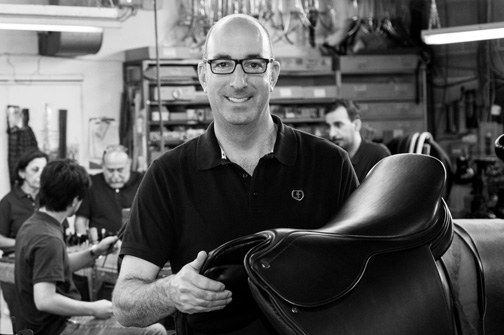Staying on the Right Tack
How to Protect your Tack and Harness

The horse show world keeps spinning even in winter months. You still make sure your horse is well-cared for and exercised even if it’s not being trained. You clean and store your show ring apparel to keep it in tip-top shape -- you even make sure YOU stay in tip-top shape. But what about your tack and harness? A frequently over-looked investment once purchased, tack and harness often gets relegated to back-of-tack room, back-of-mind awareness. But tack is a vital key in your horse’s performance, and it’s important to keep your gear in good shape for the safety of you, your horse, and the longevity of your equipment.
We asked David Freedman, 6th generation harness maker and equine industry icon, how to take care of your tack and harness investments. He graciously offered his expertise for this month’s blog:
With show season behind us, it’s time to think about longer term storage for your tack and leather products that won’t be used for several months. Many of us simply store tack as normal, throwing on a saddle cover here, bridles in a bridle bag there, or putting harness away where it can’t collect dust, expecting that this storage will also be satisfactory for a prolonged period of time. Some of you will be getting ready to show early in 2021, while others won’t break out their show tack until April. In any case, there is no better time than now to winterize your tack and keep it ready for the season ahead.
Diagnosing the Culprit: Salt
Some of us keep tack that seems to always be clean, supple and in good working order. This is tack that is safe. Others keep tack that seems to always be hanging together on its last thread… no pun intended. And many of us have a combination of both. Simply put, tack gets used if you are training or riding horses daily, and therefore, it gets worn out. Some leathers are easier to maintain than others, and some qualities of manufacture simply hold up better. One hard to control constant in all tack and leather is the salt that these pieces are exposed to when on our working horses and their sweat. This is the culprit of almost everyone’s tack care and maintenance issues. If leather is not maintained, horse sweat can burn and stiffen it like a board, almost to the point it cracks and feels brittle. To some degree, salt in sweat can even pull or absorb the natural tallows (oils) that were tanned into the leather originally making the leather feel to the hand that it needs to be conditioned or treated. It is important that salts are neutralized so that the lifespan of the leather can be realized.
Oils vs. Conditioners
Neutralizing salts requires balancing the ph levels in the leather. Commonly, fatty acids used in the ingredients of saddle soaps can do this. Then, conditioners must be applied to feed the leather hide and keep it supple. It should be noted that leather items that are of high quality may be stitched with Irish linen thread. We do not recommend oils for these high-quality items as many oils can strip the natural wax coating from the thread, creating thread rot. The actual loosening of the yarn’s fibers creates a weak or loose stitch in the leather. Obviously, you wouldn’t want things to literally come undone while in daily use, therefore stay away from oils and use conditioners. At Freedman’s, we recommend our Luxury Saddle & Leather Conditioner. See our Care & Maintenance page online for more products and recommendations on leather care.
Setting Yourself Up for Leather Care Success
Winter months are the perfect time to get your tack and harness ready for the next show season. Likely you just returned home for a show and need to do a major cleaning and conditioning overhaul anyway. There is no better time than now to pull all your tack out and systematically clean and condition it, setting it up for next season.
I’m a “safety first” type of person. So, for me, the cleaning process is a great time to inspect every piece of tack that you own, even the small pieces such as bridle billets, cheek pieces, reins, and rein billets.
Start asking a few questions as you organize and get set to clean:
- What pieces are worn or cracked?
- Are the keepers intact?
- Are there any harness parts that are noticeably worn?
- Do your saddle billets need to be replaced or updated?
- Are your stirrup leathers hanging on by a thread?
- How about those adjustable bars that are worn and are now slipping?
- What pieces of harness are looking used or threadbare?
Go over every piece with a fine-tooth comb. Make a priority list of what needs to be fixed or repaired:
- What changes would you make to help a particular piece of tack improve the performance of a certain horse?
- What tack is past its lifetime and needs to be tossed out?
- And of course, what is necessary to be replaced for the coming season. Healthy tack is safe tack, and this should be a priority.
The easiest way to create this checklist and ensure that you have inspected each piece, is by cleaning and conditioning every piece of tack. This will create a systematic process that will help you to make notes of what needs to be replaced and repaired. Do your safety inspection while you dismantle each part. You will quickly determine what needs help and what is past its prime and ready to break. In turn, you can save yourself some future aggravation and possibly divert an accident if sub-standard parts are diagnosed for repair or replacement.
Here are a few resources for helping to begin the cleaning and conditioning process:
Once you have all your parts ready for repair and they are labeled with instructions, make sure you actually follow through in sending the pieces out to whomever is your preferred leather service supplier for repair and replacements. When you receive your repairs back, you can quickly determine what additional parts you will need to complete bridles and other tack to ensure you are ready to go for the next show season.
Winter well and drive on!

David Freedman, 6th generation harness maker
Freedman Harness’ tradition in the show horse industry is a long-standing one. Steeped in the traditions of equestrian sport, Freedman's harness, saddles, bridles, bags, and leather goods all echo a commitment to excellence that dates back six generations. With their roots grounded in the craftsmanship of harness, Freedman’s has expanded their repertoire to include a hand-crafted selection from their saddlery, bridlework, training equipment, handbags, and travel bags. Most recently, they launched their equestrian performance apparel line, a new favorite among riders of many disciplines. Artisans in the Toronto, Canada workshop create luxuriously handcrafted leather goods using techniques from days gone by, and the Freedman’s Boutique in Midway, Kentucky showcases their collections in the heart of horse country. With tradition embedded in every stitch, Freedman’s is proud to continue to support the saddle horse industry.
The views, information, or opinions expressed in this blog are solely those of Mr. Freedman and do not necessarily represent those of Equidae Insurance. For more information regarding this blog, please email freedman@freedmanharness.com. For more resources on Freedman’s products and how to care for them, be sure to visit FreedmanHarness.com, Freedman’s YouTube channel or their Facebook page.
HQ & Manufacturing
153 Bridgeland Ave, Unit 14
Toronto, ON, Canada M6A 2Y6
Toll-Free: 1 (877) 256-7674
Phone: (416) 256-674
USA & Boutique
136 East Main Street
PO Box 3638
Midway, Kentucky 40347
Phone: (859) 846-9674
For more information about insuring your horse, or if you have a topic you’d like to see covered in our blog, please contact us directly at: Equidae Insurance, Inc. 608 Virginia Street East, Suite 302 Charleston, WV 25301 p. (304) 346-1198 f. (304) 345-3535
Stacey Halloran, Agent
shalloran
This material is for informational purposes only. All statements herein are subject to the provisions, exclusions and conditions of the applicable policy. Coverages are subject to individual insureds meeting our underwriting qualifications and to state availability.
Recent Posts
How to Market your Show Horse
Begin with the basics to make your strategy work
Protecting Your Equine Business
Professional Peace of Mind
In any event, you need insurance
Why your Association needs equine organization and event insurance
How to File an Insurance Claim
Read this before you have to
Oh, Baby!
Steps to protecting your prospect’s health AND your investment
Wash, Rinse, Don’t Repeat
Your equine insurance renewal shouldn’t be just the same-old, same-old
Oh, Christmas Treat… Oh, Christmas Treat
The Dos and Don’ts of Feeding Barn Snacks
Why Life Insurance Is Worth Your While at Any Age
Common Misconceptions and Benefits
Protecting Your Fashion Investment
How to care for your show ring apparel
What Is Your Horse Worth?
How to Determine an Equine Insured Value
It’s Only Fun Until Someone Gets Hurt
Why you need personal equine liability insurance
Is Equine Insurance Necessary?
The short, and only, answer is YES!
Foaling: What to Expect When You’re Expecting
How to help secure the birth of a thriving foal
All Farm Insurance Is NOT Created Equal
Is your farm insurance sufficient?
The Best Coverage for Your Equine Business
Your Homeowner’s Policy May Not Be the Solution
Common Mortality Insurance Disputes
Lessons in Avoiding Legal Clashes with Insurers
Structuring an Equine Business
Let’s Talk About That
Are You Operating an Equine Business or a Hobby?
Let’s Talk About That
Business Tax Incentives for the Equine Professionals
Let’s Talk About That
Ringside Seats
Lessons Learned from Running a Horse Show
Staying on the Right Tack
How to Protect your Tack and Harness
Imagine the Possibilities
How Data Has the Power to Transform the Equine Industry
Act Now: Coronavirus Emergency Loans
How the Stimulus Program Can Help Your Equine Business
Loss of Income in the Equine Industry
The COVID-19 Impact: Can my insurance help?
You can bring a horse to water, but…
Winter weather tips for encouraging horses to drink
Be in the know with insurance lingo
A glossary to help you come to terms with your insurance policy
Prepping for a Blue-Ribbon Year
An off-season checklist for show horse trainers
Insurance for Equine Professionals
What kind of insurance does a trainer or boarding facility need?

